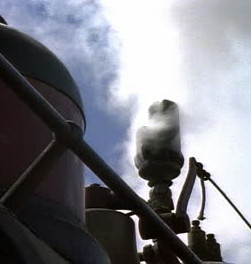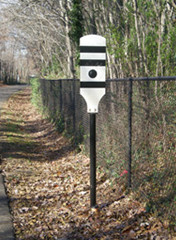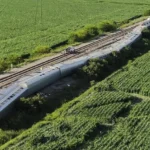A Train Whistle Mystery.
 Travel by train around the United States and, if you’re paying attention, you’ll soon notice that Amtrak engineers blow the whistle quite a lot. And if you’re really paying attention, you’ll notice that there are several different whistle patterns—for example, two short toots when the train is about to move forward; three toots when it’s about to back up.
Travel by train around the United States and, if you’re paying attention, you’ll soon notice that Amtrak engineers blow the whistle quite a lot. And if you’re really paying attention, you’ll notice that there are several different whistle patterns—for example, two short toots when the train is about to move forward; three toots when it’s about to back up.
By far the most common whistle signal is the one you hear every time the train approaches a grade crossing, which is where motor vehicles drive across the tracks. It’s long-long-short-long. There will be minor variations—sometimes it’s brisk, sometimes long and drawn out—depending on how fast the train is approaching a crossing. And sometimes you can detect a slight difference in the signal after a new engineer with a slightly different “touch” has come aboard in a crew change. But the signal itself is always the same: long-long-short-long. Furthermore, that’s the way it’s actually specified in railroad manuals.

But here’s what I find so curious: no one seems to know where long-long-short-long came from. Over the years, I’ve asked many Amtrak people, including conductors and engineers, and no one knows.
Then, the other day, I got an email from a reader who said it’s actually Morse Code for the letter “Q”. (And indeed it is: dah-dah-dit-dah.) He went on to say he was told that British ships in the late 1800s blew long-long-short-long on the ship’s horn—the letter “Q”—as a way of letting other maritime traffic know that Queen Victoria was on board and to yield the right of way. Certainly an interesting explanation … and, I thought, plausible, too.
To corroborate that explanation, I contacted Mark Smith, founder and the person behind The Man in Seat 61, the best and most complete web site devoted to rail travel anywhere in the world. As an expert on passenger rail and as a Brit, I could think of no one better to ask. Here is his response:
“The Queen story sounds apocryphal to me – though Queen Vic’s reign up to 1901 would be the right time for railroading in the US to be starting and expanding, so Q … makes (some) sense.”
So it’s only POSSIBLE that the long-long-short-long whistle signal is actually “Q” for Queen. But somewhere … some time ago … someone made the decision that trains in North America—both passenger and freight— would blow long-long-short-long when approaching grade crossings. But who? And why that specific pattern? Does anyone know?




I have recordings of the –oo whistle code for in use for grade crossings on the DRG&W as late as 1976. It was listed as an alternate code in the AAR rule book at least through that decade. Sounding a steam whistle is essentially blowing precious steam out a pipe. Thus, perhaps, the shorter code. (Just like headlight powered by steam turbines were a night-time only extravagance). With diesels, the issue became irrelevant. Continuing the sound through the crossing ensured engineers were doing all they could warning-wise and litigation-wise. Also, there are plenty of motor vehicle-train collisions where the auto or truck runs into the side of the train. That’s why modern cars have reflectors on the side.
Thanks for that!
Q is used when a train approaches an intersection, usually with a road used by vehicular traffic and means “Here comes the Queen”.
“Q” means “Quarantine,” as in “Quarantine the crossing for the approaching consist.” I just heard this explained by a knowledgeable railfan just the other day!
We were told by a train person (engineer?), that the
Q stood for the phrase “Give no quarter,” in other words, get out of the way. It seemed logical.
Interesting thought. I have to say it doesn’t seem that way to me after seeing and hearing so much about how safety is drlled into Amtrak’s operating crews. The idea that they would have a “Get the hell out of my way!” whistle signal doesn’t fit that mind-set.
I agree Jim. “Give no quarter” actually means to take no prisoners and means that the enemy will not be given “quarters” – places to stay. In other words, they will be killed. This does not make sense to use in a safety-minded organization. The “Queen” story makes sense. Another possibility is that train lingo may come from nautical lingo, in which case the “Q” is “A request for free pratique” – “Pratique is the license given to a ship to enter port on assurance from the captain to convince the authorities that she is free from contagious disease.” This makes some sense to me as well – a request to enter port – like a train requesting to enter a crossing or a station.
I believe that this is a crossing warning ahead sign, single road cross, then double road cross. The dot on the board is a flanger warning sign to lift blade as Flanger blades are commonly lifted when going over grade crossings, motor car set outs, switches and crossings with other railroads as the blade cleans inside the rails
I also wondring, why the last long whistle must be blown until the Loco has passed the crossing. What’s the idea behind this? Because…if the Loco is on the crossing, it’s to late for every warning anyway!? But sounds great while waiting at the crossing…a nice positive side effect :-D
Interessting thesis. And I (as a swiss guy) thought it’s to let pedestrians or cardrivers know, how far the train is away from the crossing….at the short sign it’s critical close…. :-)
But no matter where this sequence come from, it’s great to hear that sound in the US. In Switzerland, the trains blow their whistle only before unsecured railroad crossings. And of these there are almost no more left here. This is a pity.
Whistle signals were defined by Rule 14 in older railroad rule books. I have seen Rule Books between 1914 and 1935 where the grade crossing engine whistle signal was L-L-s-s. In a 1955 book the signal was L-L-s-L. Still looking to find the date this particular rule was changed…
Thanks very much. I was also curious about why that particular signal was put forward and by whom. I mean, why not L-s-s-L? Or L-L-s-s? Any thoughts on that?
L-L-S-S: Another friend explained it this way. The rules required that the whistle signal was to continue until the engine entered the crossing. As a result, the last short blast became a long one, hence L-L-s-L.
It’s Morse code for the letter Q and is said to mean “Here comes the queen”.
That’s my choice.